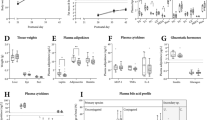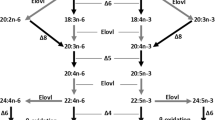Abstract
MOST vertebrate species require some dietary source of essential fatty acids (EFAs)1,2. A wide range of naturally occurring polyunsaturated fatty acids have been shown to exhibit EFA activity, but they can be classified into two homologous series characterised by the position of the terminal double bonds relative to the methyl (omega) carbon atom. The ω6 series of EFAs all have double bonds in the ω6 and ω9 positions, the ω3 series in the ω3, ω6 and ω9 positions. The metabolic interrelationships of the members of each series are shown in Fig. 1. The naturally occurring 18-carbon parent compounds for each series are linoleic acid (18:2 ω6) and linolenic acid (18:3 ω3) and EFA requirements are usually stated in terms of either or both ot these parent EFAs (p-EFAs)1,3.
This is a preview of subscription content, access via your institution
Access options
Subscribe to this journal
Receive 51 print issues and online access
$199.00 per year
only $3.90 per issue
Buy this article
- Purchase on Springer Link
- Instant access to full article PDF
Prices may be subject to local taxes which are calculated during checkout
Similar content being viewed by others
References
Alfin-Slater, R. B., and Aftergood, L., Progr. biochem. Pharmac., 6, 214–241 (1971).
Stumpf, P. K., A. Rev. Biochem., 38, 159–212 (1969).
Davidson, S., Passmore, R., and Brock, J. F., Human Nutrition and Dietetics, fifth ed., 62–77 (Churchill Livingstone, Edinburgh and London, 1972).
Inkpen, C. A., Harris, R. A., and Quakenbush, F. W., J. Lipid Res., 10, 277–282 (1969).
Ninno, R. E., De Torrengo, M. A. P., Castuma, J. C., and Brenner, R. R., Biochim. biophys. Acta, 360, 124–133 (1974).
Gershoff, S. N., in Nutrient Requirements of Laboratory Animals, 1–10 (National Academy of Sciences, National Research Council, Washington, DC, 1962).
Scott, P. P., in Canine and Feline Nutritional Requirements (edit. by Graham-Jones, O.), 75–89 (Pergamon, Oxford and London, 1965).
Sinclair, A. J., and Crawford, M. A., J. Neurochem., 19, 1753–1758 (1972).
Sprecher, H., and Lee, C. J., Biochim. biophys. Acta, 388, 113–125 (1975).
Holman, R. T., Progr. Chem. Fats other Lipids, 9, 607–682 (1970).
Greaves, J. P., thesis, Univ. London (1959).
Leoschke, W. L., and Elvehjem, C. A., J. Nutr., 69, 147 (1959).
Author information
Authors and Affiliations
Rights and permissions
About this article
Cite this article
RIVERS, J., SINCLAIR, A. & CRAWFORD, M. Inability of the cat to desaturate essential fatty acids. Nature 258, 171–173 (1975). https://doi.org/10.1038/258171a0
Received:
Accepted:
Issue Date:
DOI: https://doi.org/10.1038/258171a0
This article is cited by
-
Diet effects on longevity, heat tolerance, lipid peroxidation and mitochondrial membrane potential in Daphnia
Oecologia (2023)
-
Sex specific differences in hepatic and plasma lipid profiles in healthy cats pre and post spaying and neutering: relationship with feline hepatic lipidosis
BMC Veterinary Research (2017)
-
Polyunsaturated fats, membrane lipids and animal longevity
Journal of Comparative Physiology B (2014)
-
Maintenance of Arachidonic Acid and Evidence of Δ5 Desaturation in Cats Fed γ‐Linolenic and Linoleic Acid Enriched Diets
Lipids (2012)
-
Liver desaturase activities and FA composition in monkeys. Effect of a low‐protein diet
Lipids (2003)
Comments
By submitting a comment you agree to abide by our Terms and Community Guidelines. If you find something abusive or that does not comply with our terms or guidelines please flag it as inappropriate.



